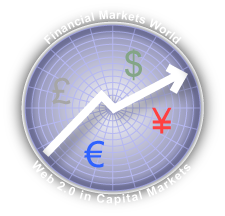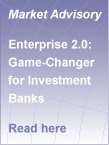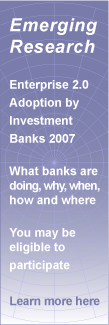A Glimpse Inside the Emerging Divide between Wall Street Professionals—How Many Goldman Employees Are on Facebook?
 The Global Human Capital Journal’s coverage of Financial Markets World’s Web 2.0 in the Capital Markets Industry conference continues. In this session, Tom Steinthal of the BSG Alliance wrapped the conference by crystallizing several Web 2.0 concepts with passion and panache. Tom is Managing Director of BSG Alliance’s Financial Services practice. Previously he has managed equities technology teams at Goldman Sachs, Donaldson, Lufkin & Jenrette, Credit Suisse, JPMorgan Chase and Prudential. Further back, he led Nasdaq technology teams and designed and implemented Nasdaq trade order management and market making systems. He has been a member of various Nasdaq and NASD technology committees and has been Series 7, 3 and 55 licensed.
The Global Human Capital Journal’s coverage of Financial Markets World’s Web 2.0 in the Capital Markets Industry conference continues. In this session, Tom Steinthal of the BSG Alliance wrapped the conference by crystallizing several Web 2.0 concepts with passion and panache. Tom is Managing Director of BSG Alliance’s Financial Services practice. Previously he has managed equities technology teams at Goldman Sachs, Donaldson, Lufkin & Jenrette, Credit Suisse, JPMorgan Chase and Prudential. Further back, he led Nasdaq technology teams and designed and implemented Nasdaq trade order management and market making systems. He has been a member of various Nasdaq and NASD technology committees and has been Series 7, 3 and 55 licensed.
Wall Street firms will increasingly get caught up in several threads of culture change, but he emphasized two: the generational divide and, related to it, collaboration vs. control. In this context, “building an enterprise 2.0 system ’employees’ will use” must take into account very different styles of working and sensibility—and they must be able to play together well. As is customary, we summarize Tom’s remarks before adding our analysis and conclusions.
Broad Themes
- The push economy is over; the new way to collaborate is to iterate (in the sense of fast software development). Set expectations, put ideas or information offerings out there (on a blog) and let stakeholders comment and contribute to fleshing out (or trashing; kill losers fast) the idea. Tom also pointed out that productivity is shifting from personal (read “in a cube”) to group (read “social”) productivity.
- Eye-opening stats from his presentation: How many employees are using Facebook at Goldman Sachs?
- Goldman Sachs – 5,510 or 19.7%
- Deutsche Bank – 7,636 or 11.3%8
- Lehman Brothers – 2,951 or 10.4%
- UBS – 8,101 or 10.4%
- Morgan Stanley – 5,689 or 10.3% (Adam Carson is probably responsible for many of them)
- Tom pointed out that the “junior staff” is native with Web 2.0 tools. They are wired completely differently in that they work by “social collaboration.” Echoing this, Adam Carson puts it bluntly, “Basically Morgan Stanley faces the choice of forcing the younger generation to learn the old way of doing business or adapting to new models of work and organization.” This shift in generational sensibilities will be an interesting cocktail when consumed within investment banks, many (most) of which are not very group-oriented today.
- Referencing Anne Truitt Zelenka’s seminal “Busyness vs. Burst article,” Tom described the “new knowledge worker” (somewhat too predictably the “knowledge worker 2.0” ,^):
 The Knowledge Worker 1.0 (picture balding man, wire rims slipped halfway down nose, holding a dictionary) is defined by: limited location and role, stuck at a desk using email and standard tools, custodian of information (read “monger”), inside the wall, sees knowledge as a process (light on brainstorming), and uses rigid ways of organizing information. Behaviorally, he expects immediate response to emails, he’s always available, believes that Web surfing (probably still uses the phrase) is a waste of time.
The Knowledge Worker 1.0 (picture balding man, wire rims slipped halfway down nose, holding a dictionary) is defined by: limited location and role, stuck at a desk using email and standard tools, custodian of information (read “monger”), inside the wall, sees knowledge as a process (light on brainstorming), and uses rigid ways of organizing information. Behaviorally, he expects immediate response to emails, he’s always available, believes that Web surfing (probably still uses the phrase) is a waste of time.- The Knowledge Worker 2.0 (image 20-something, edgy but not too chic glasses and coif) has these characteristics: all over the organization, broad skills on a solid base, uses many tools, no particular age, connects with colleagues, peers and client in communities everywhere, understands how things get done, is knowledgeable, engaged, and contributing, and shares and distributes information freely. Behaviorally, she may not respond to email at all; she’s probably chatting with 1.0 and has attached several files and links, but 1.0 has forgotten his login and never thought to check in the first place. Many 2.0s don’t use email terribly often; one speaker recently even reported having to have “email classes” for new hires!
- 1.0 was “busy” and concerned with face time, 9 to 5 (and defined benefit), while 2.0 is “bursty”; she’s on Facebook and other social network sites all the time, but management doesn’t get that students use Facebook as a collaboration platform, and ideas come from anywhere, especially social places. To 1.0 colleagues (and bosses), she doesn’t seem to “work” but “somehow” produces excellent work.
- Tom pointed out that organizations need 1.0 and 2.0 workers; it’s all about balance.
- Organizationally, we’re shifting from hierarchical, closed, managed companies to peer-oriented, open, self-organizing enterprises (sounds familiar).
Leading the Transition to Enterprise 2.0 at Capital Markets Firms
So how do enlightened managers make this shift happen gracefully? Here are Tom’s observations and suggestions. Use several approaches to driving change:
- Top down: blog what’s on your mind, let people respond to it and turn it into a conversation. This is leading by example, and executives of capital markets firms should take note. Encourage people to use wikis to manage meetings. Drastically reduce email volume by using RSS for employee and reporting processes.
- Bottom up: mandate teams to jettison (fat client) office suites for creating project documents. Use wikis because they are much more efficient. Try zoho online collaboration software, google docs and twitter. Of the latter, Tom said that, although it has been mostly known for cell phone SMS blogging, it’s invaluable for global project teams because they stay in touch and become aware of work rhythms.
- His message to MDs (managing directors): encourage top down and bottom up as fast as you can.
- Leadership needs to adjust incentives, away from superstar individualists to group. People can compete very effectively in groups, too, but incentives must resonate with group collaboration, and they don’t now, at most firms.
- Mashups aren’t ready yet; IT must step on it to build APIs (I think he meant “pedal to the metal SOA so you can expose everything as services”).
- Obviously, Wall Street poker is a major deterrent to collaboration and sharing; since information can make or break deals, the industry’s DNA is to play cards close to the vest. That will be hard to change.
- Tom’s the second person to say this recently. You don’t have to show people how to adopt enterprise 2.0 because it’s so easy.. but you have to show them why because it’s counterintuitive for knowledge worker 1.0s.
- When you can, turn people loose and let them solve real problems with the new tools; that way, your firm can understand the potential.
 Analysis and Conclusions
Analysis and Conclusions
- Enterprise 2.0 will happen, and firms will be well served to adopt as early as is feasible. In a different but highly congruent context, I have seen quantum leaps of performance improvement when making transitions like this. For example, in enterprise software development, going from long-cycle, waterfall development to short-cycle, iterative development is an incredible leap that people can’t possibly appreciate until they do it. Waterfall development features a long, upfront requirements phase, which is followed by a much longer development cycle. In iterative development, requirements are done in short bursts that are followed by development and extensive client communication. This works much better because change in the business world is constant, and shorter cycles accommodate change much better because they’re in sync. All these enterprise 2.0 tools work on a similar principle: bursty, frequent communication that’s highly leveraged.
- Saying that employees should collaborate more is easy for anyone to say, but it is difficult to communicate the profound change that this represents. As I have written extensively, for most of human existence, information has been scarce, and people derived power by hoarding it. In the Knowledge Economy, information is everywhere, and it ages quickly; people gain much more leverage by sharing and collaborating, in fast cycles. This is a profound change that few people and workers appreciate. Much discontinuous change will happen around it because it’s under the radar.
- Picking up on Tom’s comment (and passion) for blogging, “putting things out there and iterating”: customers increasingly love this type of engagement and participation. Give them the choice to participate. I would go a step further by saying that they will increasingly expect the ability to collaborate with you; being part of the process actually gives them more utility. This is hard for product-centric companies to understand; the value will, especially for the Web 2.0 generation, migrate away from product and service to the collaborative process and relationship with you. No, it won’t happen overnight, but this will increasingly be a factor in winning and retaining customers.

The slides for this presentation are at: http://www.slideshare.net/steint/building-an-enterprise-20-system-employees-will-actually-use
Thanks for the review and the insightful comments.